
Microsoft is hard at work on PowerToys for Windows 10. This open-source project adds many powerful features to Windows, from a bulk file renamer to an Alt+Tab alternative that lets you search for windows from your keyboard.
We originally published this article on April 1, 2020. We’ve updated it with information about the latest PowerToy: Awake. It’s a part of PowerToys 0.41.2, which Microsoft released on June 28, 2021.
How to Get Microsoft PowerToys
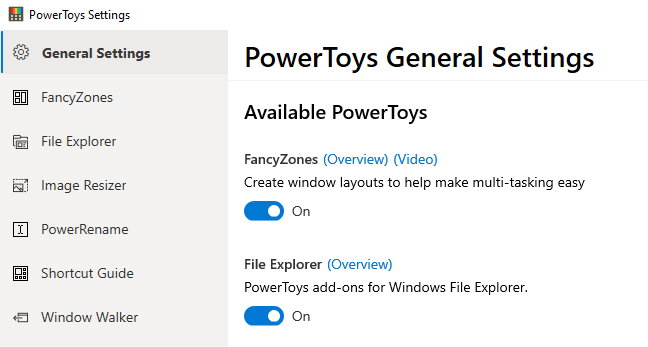
You can download PowerToys from GitHub and enable the features you want from within the PowerToys Settings application. It’s free and open-source. Download the “PowerToysSetup” MSI file from the website and double-click it to install it.
To access PowerToys settings after installing and launching the application, locate the PowerToys icon in the notification area (system tray) on your taskbar, right-click it, and select “Settings.”

How to Update PowerToys
Do you have an older version of PowerToys installed? You can now check for updates right from the General Settings pane. Under General Settings, scroll down and click “Check for updates” at the bottom of the pane to check for a new version.
Starting in version 0.18, you can also enable a “Download updates automatically” feature to have PowerToys automatically download and install updates.

If you don’t see this button, you’ll have to download the latest PowerToys package from GitHub and install it to update.
Awake, a Quick Way to Stop Your PC From Sleeping

Whether you’re downloading a file or performing another long-running task, sometimes you just don’t want your PC to go to sleep. You can go into Settings and tell Windows to never sleep, wait for the task to complete, and then go back into Settings and change the setting back. Of course, that’s a lot of clicks—and it’s easy to forget to re-enable sleep mode.
PowerToys Awake gives you a quick notification area icon that lets you control sleep settings. You can have your PC never go to sleep until you tell it not to. Or, you can configure your PC to only stay awake until a predetermined time you set.
RELATED: How to Temporarily Stop Your Windows PC from Sleeping
Color Picker, a Speedy System-Wide Color Picker

People who work with graphics, from web designers to photographers and graphics artists, often have to identify a specific color and use it. That’s why tools like Photoshops have a color picker (eyedrop) tool that lets you point your mouse cursor at part of an image to identify precisely what color it is.
Color Picker is an eyedrop tool that works anywhere on your system. After enabling it in PowerToys, press Win+Shift+C to open it anywhere. You’ll see the color code displayed in both hex and RGB so you can use it in other programs.
Click once and the hex color code will be copied to your clipboard so you can paste it. If you prefer RGB, you can open the Color Picker screen in the PowerToys Settings window and choose to instead copy the RGB color code when you click.
PowerToys Run, a Quick Application Launcher
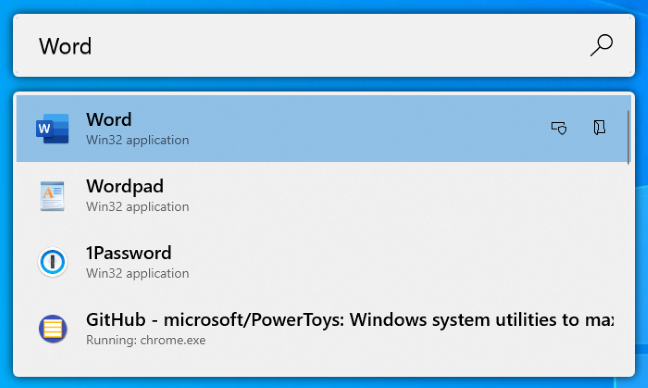
PowerToys Run is a text-based application launcher with a search feature. Unlike the classic Windows Run dialog (Win+R), it has a search feature. Unlike the Start menu’s search box, it’s all about launching things on your computer instead of searching the web with Bing.
In addition to applications, PowerToys Run can quickly find files. It can even find and switch to open windows—just search for their window title.
To open it, press Alt+Space. This keyboard shortcut is customizable from the PowerToys Run pane in PowerToys Settings.
Start typing for a phrase to search for applications, files, and even open windows. Use the arrow keys to select an item in the list (or just keep typing to narrow it down) and press Enter to launch the application, open the file, or switch to the window.
PowerToys Run has some other features, like an “Open as Administrator” and “Open Containing Folder” button for each option in the list. In the future, it will have plug-ins like a calculator.
Keyboard Manager, for Remapping Keyboard Shortcuts
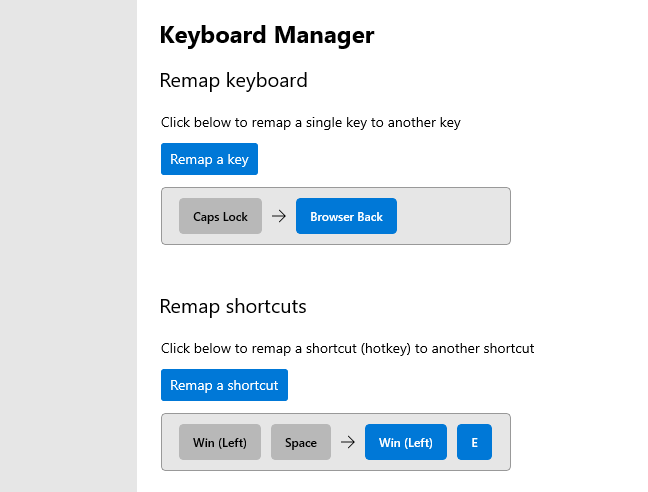
Keyboard Manager provides an easy interface for remapping single keys on your keyboard and multiple-key shortcuts.
The “Remap Keyboard” tool lets you change a single key to a new key. You can make any key on your keyboard function as any other key—including special function keys. For example, you could turn the Caps Lock key you never use into a Browser Back key for more easily navigating the web.
The “Remap Shortcuts” pane lets you change multiple-key shortcuts into other shortcuts. For example, Win+E normally opens a File Explorer window. You could create a new keyboard shortcut Win+Space that opens a File Explorer window. Your new keyboard shortcuts can override existing keyboard shortcuts built into Windows 10.
PowerRename, a Bulk File Renamer
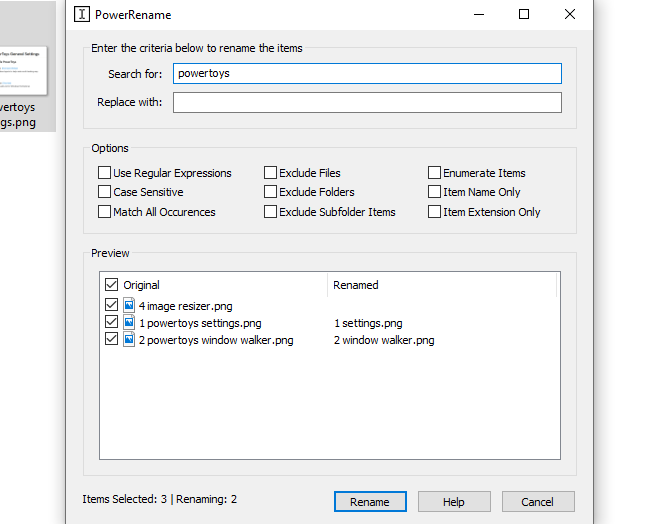
Microsoft’s PowerToys include a batch renaming tool named “PowerRename.” With this feature enabled, you can right-click one or more files or folders in File Explorer and select “PowerRename” in the context menu to open it.
The PowerRename tool window will appear. You can use the text boxes and checkboxes to quickly batch rename files. For example, you can remove words from a file name, replace phrases, add numbers, change multiple file extensions at once, and more. You can even use regular expressions. The preview pane will help you fine-tune your renaming settings before you go through with renaming the files
This utility is much simpler than most of the third-party batch rename tools available for Windows.
Image Resizer, a Bulk Image Resizer
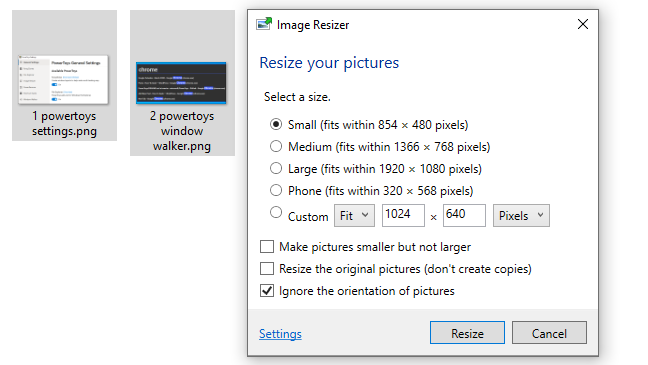
PowerToys offers a quick image resizer that integrates with File Explorer. With it enabled, select one or more image files in File Explorer, right-click them, and select “Resize Pictures.”
The Image Resizer window will open. You can then choose a size for the image files or enter a custom size in pixels. By default, the tool will create resized copies of the selected image files, but you can also have it resize and replace the original files. You can even click the “Settings” button and configure advanced options like image encoder quality settings.
This tool is a quick way to resize one or more image files without opening a more complicated application.
FancyZones, a Zone-Based Window Manager
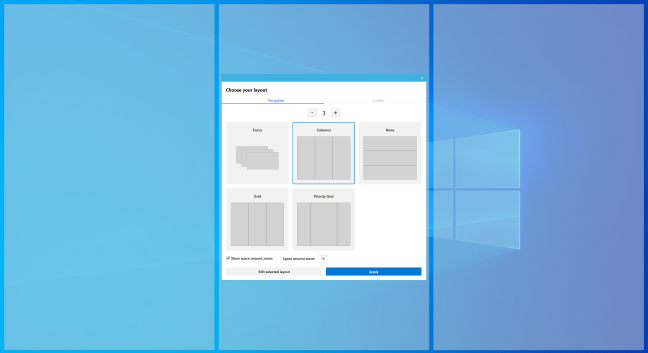
FancyZones is a window manager that lets you create layouts of “zones” for windows on your desktop. Windows normally lets you “snap” windows in a 1×1 or 2×2 arrangement. FancyZones lets you create more complex layouts.
By default, you can press Windows+` (that’s a tilde, the key above the Tab key) to open the Zone Editor. Then, while dragging and dropping a window, you can press and hold the Shift key (or another mouse button, like your right mouse button) to see the zones. Drop a window in a zone and it’ll snap to that layout on your screen.
FancyZones offers a quick way to setting up complex window layouts without carefully resizing each window. Just drop windows into the zones. You can configure all of its many options and keyboard shortcuts by opening the PowerToys Settings window and clicking “FancyZones” in the sidebar.
Shortcut Guide (for the Windows Key)
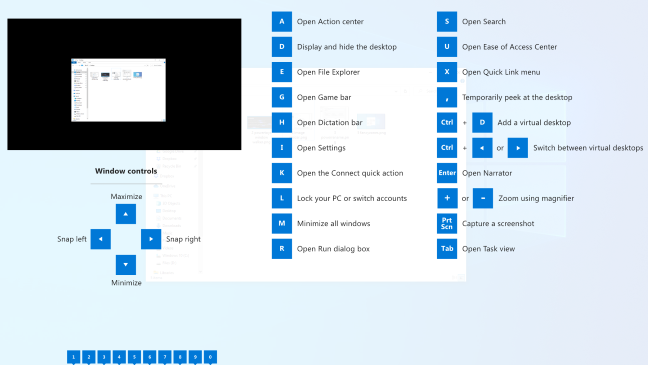
Windows is packed with keyboard shortcuts that use the Windows key. For example, did you know that you can press Windows+E to open a File Explorer window, Windows+i to open a Settings window, or Windows+D to show your desktop? You can also press Windows+1 to activate the first application shortcut from the left on your taskbar, Windows+2 to activate the second, and so on.
The Windows Key Shortcut Guide will help you learn and remember these shortcuts. With it enabled, you can hold the Windows key on your keyboard down for about one second to view an overlay that displays common shortcuts. Release the key to dismiss the overlay.
File Explorer Preview (for SVG and Markdown)
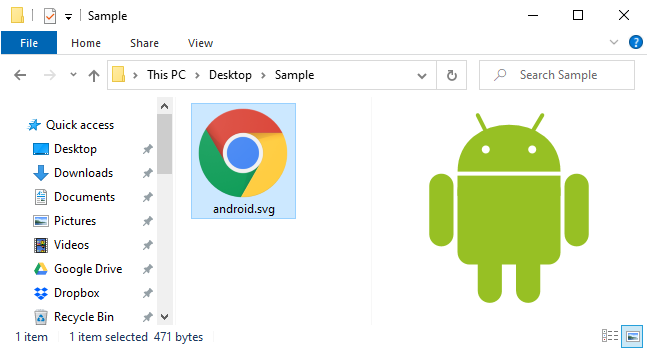
File Explorer has a preview pane, which can show previews of images and other file types directly in File Explorer. Press Alt+P in File Explorer to show or hide it. Select a file and you’ll immediately see a preview.
With the File Explorer Preview handlers enabled in PowerToys, Windows will be able to show previews of SVG (scalable vector graphics) images and documents formatted in Markdown.
What Happened to Window Walker?
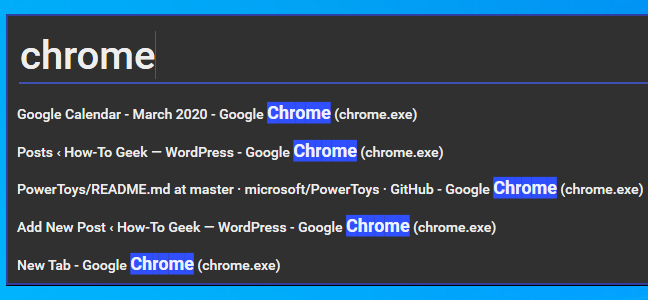
Update: This PowerToy has now been merged into PowerToys Run. You can type the title of a window into the PowerToys Run box to find and switch to it.
Window Walker is a text-based Alt+Tab alternative with a search feature. To open it, press Ctrl+Win. You’ll see a text box appear.
Start typing a phrase to search for open windows that match it. For example, if you have multiple Chrome browser windows open, you can type “Chrome” and you’ll see a list of them. Use the arrow keys to scroll through the windows and press Enter to select one.
This tool can be very helpful if you have a lot of windows open and are digging for one in particular. For example, if you have ten different browser windows open and you’re looking for one that’s showing a particular website, you can press Ctrl+Tab, start typing the name of the website, and find the browser window displaying that website.
The PowerToys package is still in its early stages, with more tools planned before the 1.0 release. Microsoft expects to release the final version in September 2020.
We’ll keep this article updated with new features as they’re released.
